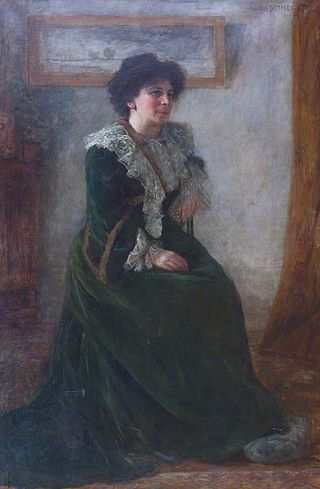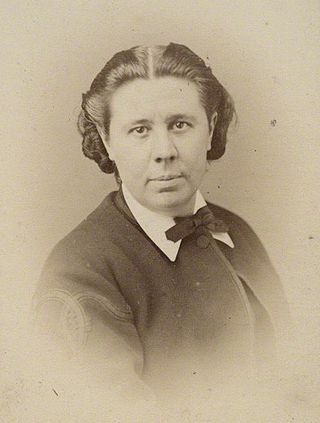
Elizabeth Garrett Anderson was an English physician and suffragist. She is known for being the first woman to qualify in Britain as a physician and surgeon and as a co-founder and dean of the London School of Medicine for Women, which was the first medical school in Britain to train women as doctors. She was the first female dean of a British medical school, the first woman in Britain to be elected to a school board and, as mayor of Aldeburgh, the first female mayor in Britain.

Dame Millicent Garrett Fawcett was an English political activist and writer. She campaigned for women's suffrage by legal change and in 1897–1919 led Britain's largest women's rights association, the National Union of Women's Suffrage Societies (NUWSS), explaining, "I cannot say I became a suffragist. I always was one, from the time I was old enough to think at all about the principles of Representative Government." She tried to broaden women's chances of higher education, as a governor of Bedford College, London and co-founding Newnham College, Cambridge in 1875. In 2018, a century after the Representation of the People Act, she was the first woman honoured by a statue in Parliament Square.

Girton College is one of the 31 constituent colleges of the University of Cambridge. The college was established in 1869 by Emily Davies and Barbara Bodichon as the first women's college in Cambridge. In 1948, it was granted full college status by the university, marking the official admittance of women to the university. In 1976, it was the first Cambridge women's college to become coeducational.

Anne Jemima Clough was an early English suffragist and a promoter of higher education for women. She was the first principal of Newnham College.

Phoebe Sarah Hertha Ayrton was a British engineer, mathematician, physicist and inventor, and suffragette. Known in adult life as Hertha Ayrton, born Phoebe Sarah Marks, she was awarded the Hughes Medal by the Royal Society for her work on electric arcs and ripple marks in sand and water.
The English Woman's Journal was a periodical dealing primarily with female employment and equality issues. It was established in 1858 by Barbara Bodichon, Matilda Mary Hays and Bessie Rayner Parkes. Published monthly between March 1858 and August 1864, it cost 1 shilling. After 1860 the Journal was published by Victoria Press in London, which was run by Emily Faithfull (1835–1895). She employed women workers, contrary to current practice in that period.

Emily Faithfull was an English women's rights activist who set up the Victoria Press to publish the English Woman's Journal.

Barbara Leigh Smith Bodichon was an English educationalist and artist, and a leading mid-19th-century feminist and women's rights activist. She published her influential Brief Summary of the Laws of England concerning Women in 1854 and the English Woman's Journal in 1858. Bodichon co-founded Girton College, Cambridge (1869). Her brother was the Arctic explorer Benjamin Leigh Smith.

A movement to fight for women's right to vote in the United Kingdom finally succeeded through acts of Parliament in 1918 and 1928. It became a national movement in the Victorian era. Women were not explicitly banned from voting in Great Britain until the Reform Act 1832 and the Municipal Corporations Act 1835. In 1872 the fight for women's suffrage became a national movement with the formation of the National Society for Women's Suffrage and later the more influential National Union of Women's Suffrage Societies (NUWSS). As well as in England, women's suffrage movements in Wales, Scotland and other parts of the United Kingdom gained momentum. The movements shifted sentiments in favour of woman suffrage by 1906. It was at this point that the militant campaign began with the formation of the Women's Social and Political Union (WSPU).

Dame Louisa Innes Lumsden was a Scottish pioneer of female education. Lumsden was one of the first five students Hitchen College, later Girton College, Cambridge in 1869 and one of the first three women to pass the Tripos exam in 1873. She returned as the first female resident and tutor to Girton in 1873.

The Kensington Society (1865–1868) was a British women's discussion society in Kensington, London, which became a group where rising suffragists met to discuss women's rights and organised the first campaigns for female suffrage, higher education and property holding.

Elizabeth Rayner Belloc was one of the most prominent English feminists and campaigners for women's rights in Victorian times and also a poet, essayist and journalist.

Henrietta Maria Stanley, Baroness Stanley of Alderley, was a British Canadian-born political hostess and campaigner for the education of women in England.

Margaret Caroline Llewelyn Davies was a British social activist who served as general secretary of the Co-operative Women's Guild from 1889 until 1921. Her election has been described as a "turning point" in the organization's history, increasing its political activity and beginning an era of unprecedented growth and success. Catherine Webb considered Davies's retirement such a significant loss for the Guild that she began writing The Woman with the Basket, a history of the Guild to that time.
Charlotte Manning was a British feminist, scholar and writer. She was the first head of Girton College.
Lady Louisa Sophia Goldsmid was a British philanthropist and education activist who targeted her life at improving education provision for British women. She took a leading role in persuading Cambridge University to create women graduates.
John D. Davies was a Welsh priest. He was born in Llanddewi-Brefi, and attended school in Lampeter, before moving to study at Queens' College, Cambridge, in 1820. Following his ordination into the Church of England in Norwich, he became rector of St. Pancras, Chichester. In 1840 he moved to Gateshead, Durham, before in 1853 becoming Honorary Canon of Durham Cathedral. He remained there until retirement in 1860.

Theodora Llewelyn Davies was a British barrister and penal reform campaigner. She was the first woman to apply for admission to the British legal profession's Inner Temple in 1920 and one of the first to be admitted in November 1922.
Alice Gruner (1846–1929) was a lecturer, social worker, and a principal founder of the Women's University Settlement, Southwark.
Caroline Anna Croom Robertson, born Caroline Anna Crompton was a British suffragist and college administrator. She was the secretary and later bursar of Girton College, Cambridge - the first university college in England to admit women.

















